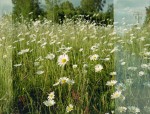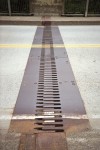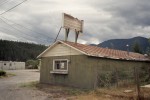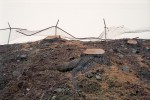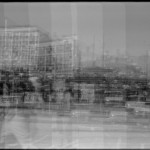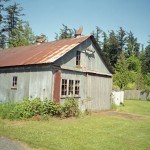Dec
23
2015

I have a limited selection of lenses for my Konica Autoreflex T but one of them is a 57mm f1.4 which is a little longer than most lenses considered to give a normal view on 35mm film. Also at 1.4 its quite fast and helps supply a nice bright viewfinder image which is good because it also provides very shallow depth of field which I may have gone a little wild with on this roll of film. I really like the bokeh and general look from the lens although images from it can stand a little boost in contrast.
no comments | tags: film, Konica | posted in Cameras, Photography
Apr
3
2015

If creating sharp undistorted well exposed images are your aim then move along this is not the camera for you. If you want a built-in ‘Lens-Baby’ like experience then this is the camera. The center of the image is bounded by a cocoon of soft distortion. There is one single aperture of f6.7 for the 28mm lens and the shutter is limited to 1/60 of a second with flash and 1/60 – 1/180 without. The lens appears to be plastic and without any coatings. The focus is fixed but works well enough at f6.7 to provide enough depth of field to render most things in focus. A non adjusted image looks a little like this.

So let me re-iterate this is the camera for taking distorted pictures but not for capturing that once in a lifetime moment you’ve always imagined you will print and put in a gallery.
no comments | tags: film, Konica, Photography | posted in Cameras, Photography
Oct
26
2014
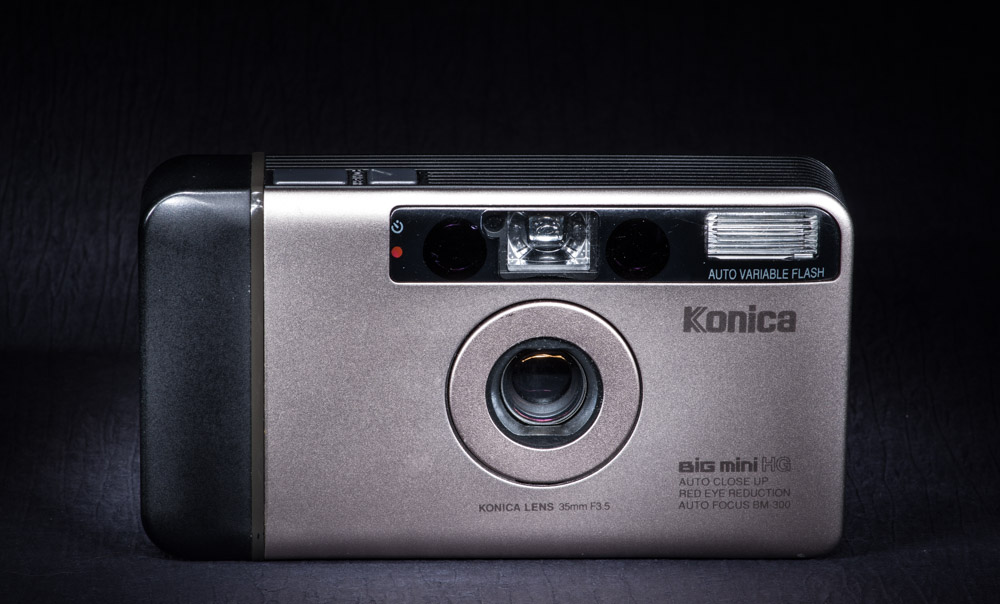
Question: What do you get when a camera isn’t fully advancing between frames?
Answer: Its worth a thousand expletives

I often get exactly what I deserve when I test old cameras that no one wants anymore. There may be a reason someone tossed that camera away but…
If the camera makes a whir I will not be deterred.
If the film will load I won’t be slowed.
I won’t quit even if the camera is shi.…… You get the idea.
no comments | tags: film, Konica | posted in Cameras, Photography
Sep
22
2014

Most cameras have a mechanism to ensure that the film is advanced to the next frame before you can release the shutter again, what a shame. Yes that helps to make sure you don’t get a double exposure of a squirrel on your favourite aunt’s head but it prevents experimentation of multiple images stretched across the film. Enter the Konica 1 to save the day and put that squirrel right where it belongs and provide the ability to trip that shutter as many times as you want, film advance or not. My favourite thing to do with the Konica 1 is to take a picture then advance the film only partially and then take another each time panning from left to right. Going from left to right is important because the image is recorded upside down and backwards on the film (That’s how lenses work). The result is something like this.

And the other thing I like to do is take multiple exposures therefore collecting the light from different times all onto the same image. Like this one which represent a short drive.

More experimentations with the Konica 1 can be seen here Multiple Exposures and Multiclick
no comments | tags: film photography, Konica | posted in Cameras, Photography
Dec
4
2013

My mistake its the Big Mini, a great little camera that fits neatly into a camera bag owing to its flat sides without any protuberances when turned off (I had to add that last part when I realized the picture I took of it had it’s lens sticking out). And it’s that lens that makes this camera one to have. I haven’t been disappointed yet when using this camera the exposures have been right on and the image quality great. More Konica Big Mini
1 comment | tags: film, Konica | posted in Cameras, Photography
May
24
2013

The Konica EE Matic doesn’t require a battery, that’s a good thing because I’m not sure it deserves one. I guess if your intention is to take pictures that have the look of having been taken with a cheap 1960’s rangefinder nothing beats a cheap 1960’s rangefinder. It has that in spades. If it’s a quality image your after then there are better options. The problem is the lens it has very bad coma distortion which results in the image being stretched the further it is from the center. This distortion could be reduced by stopping the lens down but as the camera has completely automatic exposure that is not under your control.
On the other hand it has a nice bright viewfinder that also indicates the shutter speed and it won’t release the shutter if there isn’t enough light for a proper exposure, like when you leave the lens cap on, it happens.
no comments | tags: film, Konica, Photography | posted in Cameras, Photography
Dec
23
2012

I’ve used the Konica I for this previously because of it’s completely separate shutter and film advance as well as the way that the film advance moves in little click steps. Because the image is formed upside down and backwards on the film you need to pan from left to right to make a stitch where the image sides line up. I made no effort to actually align the images but allowed them to overlap and even did a few multiple exposures where I didn’t advance the film at all. I wouldn’t say I think the results were great but an interesting beginning. One of the limits of photography is the concept of a single image representing a moment of time. This is a break from that boundary and I believe is worthy of further exploration.
2 comments | tags: BW, film, Konica | posted in Photography
Dec
21
2012

Note the letter Q is silent. If you’ve stumbled across this information erroneously in an effort to find something meaningful on the Internet my apologies. So what is this oddity? I’m pleased you asked, no one else ever does. I’ve taken the lens from an APS film Konica Revio CL which has a 25mm focal length and a speed of 1:6.7 and adapted it to the Pentax Q mount. In order to do this I’ve duplicated the distance from the back of the lens to the film only now it’s to the sensor. During the disassembly I preserved the helical focus mechanism. I now turn it by hand using a small stud threaded into the decorative front of the lens. The lens itself is no great performer it’s 3 elements in three groups and doesn’t appear to have any coatings. I’ve found that despite my best efforts at focus most of my mid to far distance shots are on the soft side. This could partially be attributed to defraction caused by the 6.7 f-stop. Where this lens does perform well is at close distances and as a macro lens. The 25mm focal length on the Q yields a “35mm full frame” equivalent of 138mm, that coupled with the fact that the over-ridden focus allows you to get within inches of the subject, you have a large degree of magnification. 
Back to the Q being silent, not only is the Letter Q silent in the name of this lens the camera itself is completely silent as it now uses its electronic shutter. A note on focus. In order to focus reasonably well I’ve turned on focus peaking which was added to the Q with firmware upgrade 1.10, additionally I’ve set 4 times magnification on when manually focusing. The magnification is enacted by pressing OK on the rear control dial. To provide an idea of how small an object you can photograph with this lens here is a lilliputian mushroom in front of a pad lock key. 
For me I see using the Pentax Q as an opportunity to expand the boundaries of what I’m able to photograph, this is the reason I recently purchased the Pentax fisheye lens and am building lenses that do something I can’t do with any of my other gear. Next on my build list are a wide-angle and a telephoto.
3 comments | tags: Konica, lens, Pentax | posted in Cameras
Jun
21
2012

The Konica Lexio 70 was introduced in 2000 and thankfully wasn’t the hope for the new millennium because despite having good specifications on paper it’s let down by a lens that creates images unsafe for viewing. Perhaps not quite that bad but I would include this camera in the Lo-Fi category along with plastic lens cameras just because of the distortion and ugly bokeh
A weird thing about the Konica Lexio 70 is that when it focuses the viewfinder framing changes with the lens focus movement, I can’t tell if the image is captured with the new framing after this change of view. Also a design fault with this camera is the lens cover on/off switch. It performs it’s on off function at the most inopportune time with the slightest movement of the lens cover.
You can see in the following image that the bokeh is horrible, as this is the only Lexio 70 I have to test I don’t want to make any presumptions but I will, I doubt it gets much better. It also has some weird pincushion distortion at the wide end that isn’t even across the frame. I found another persons set on Flickr had the same distortion so I believe it’s a characteristic of the camera. This appears most obviously with straight lines that become stretched upwards towards the edges. This may be caused by the aspherical elements in the lens and is much more dramatic than with a simpler lens design.

What I do like about it is that although it resets to full auto after powering off and on it does remember the last setting you had selected so that when you press the mode button it jumps to that one, which can be any of the eight over rides it provides.

As it affords a 28mm focal length at the wide end, which is somewhat rare in a point and shoot, it’s worth picking one out of the thrift store pile for a couple dollars. That is as long as you know the limitations.
1 comment | tags: camera, film, Konica | posted in Cameras, Photography, Uncategorized
Dec
21
2011

Something happened along the way to this blog post. I had originally intended to show the difference in output from these two cameras using their respective film formats (35mm for the Big Mini and APS for the Super Big Mini) but the thing is that it really is indisputable that 35mm film is better so I decided to just throw all of the shots together and forget about it. Several things are apparent however. The wide aspect of the APS film can be used to make an interesting difference in some compositions, it amounts to 16:9 when you use the entire frame and the other thing is that the Super Big Mini has quite a bit of vignetting with the larger 35mm film.

Big Mini and Super Big Mini (which is actually a double oxymoron)
6 comments | tags: 35mm, APS, film, Konica, mini | posted in Cameras, Photography





























